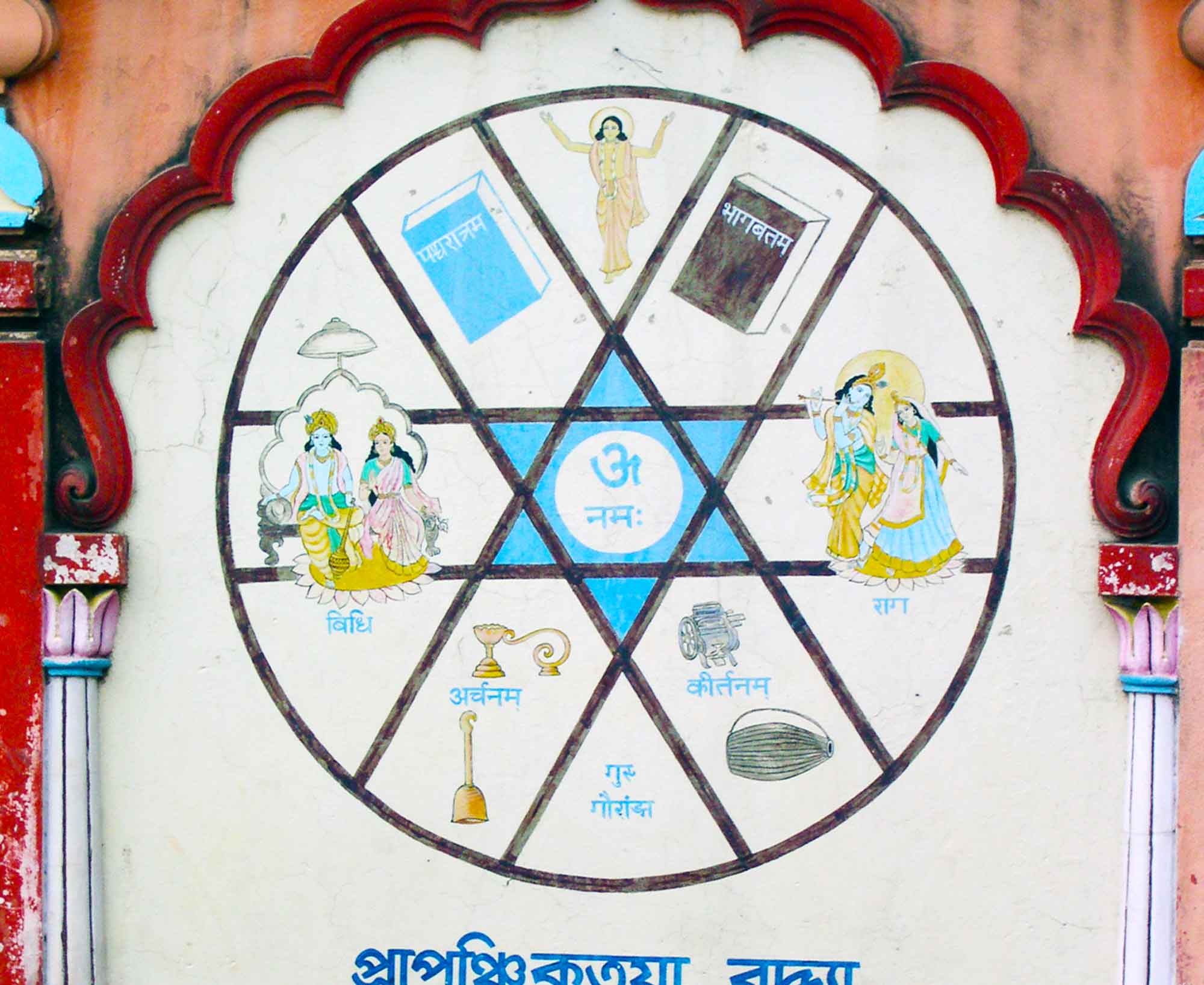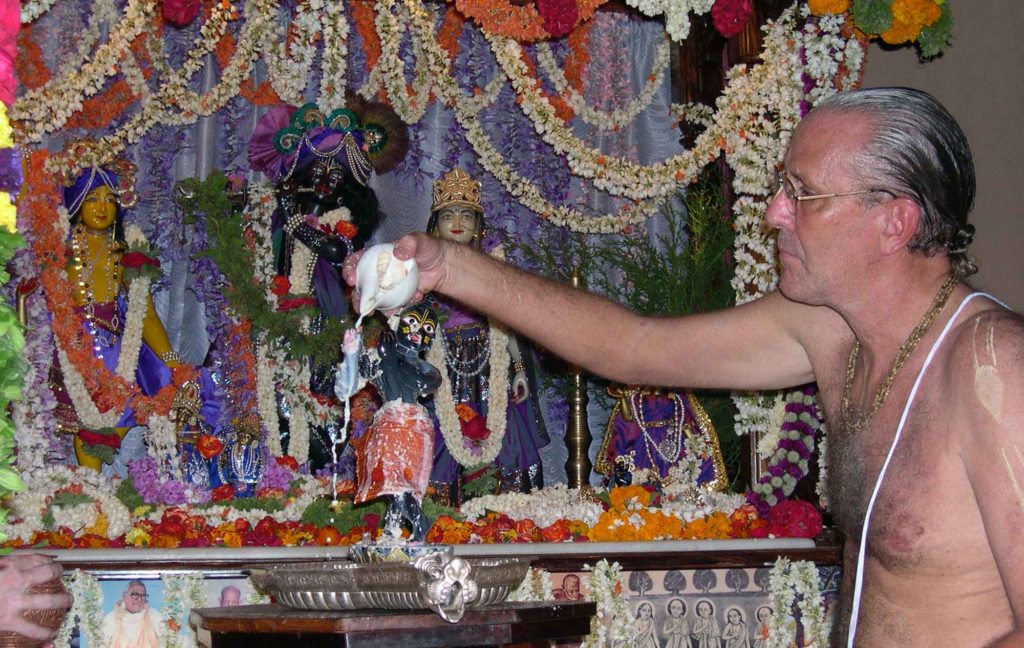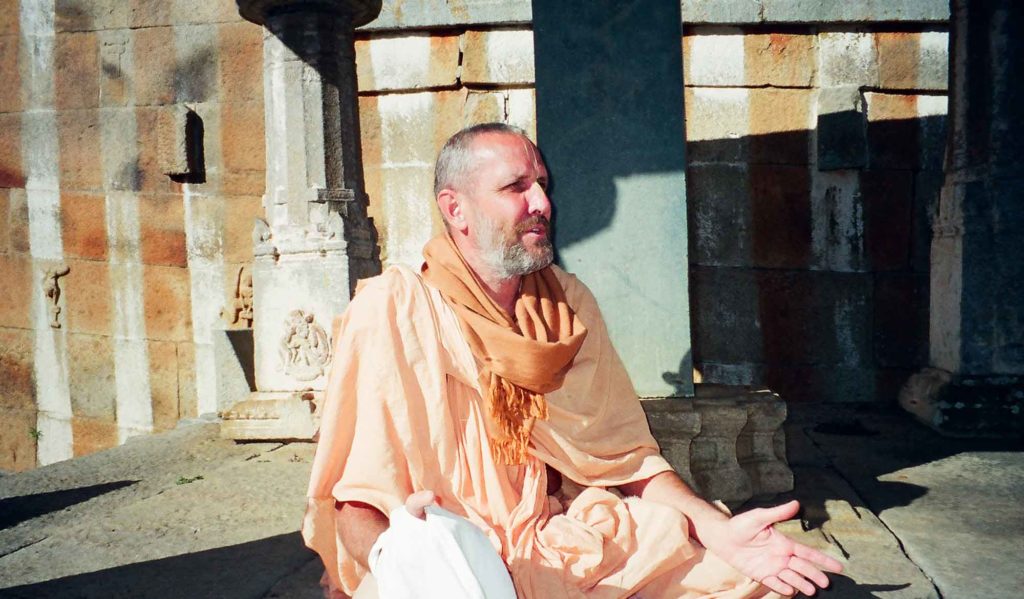Overview
‘Society Consciousness vs. Kṛṣṇa Consciousness’ was written by Swami B.G. Narasingha on October 16th 2006. This article was in response to an Iskcon guru/GBC stating that there was no room for Bhaktisiddhānta Sarasvatī Ṭhākura in Iskcon.
Question: I read a recent article on the internet by a leading ISKCON sannyāsī/GBC/guru wherein he says,
“We cannot even extend this family (ISKCON) to Śrīla Bhaktisiddhānta. We cannot even take one step forward because the problem is if we put too much emphasis on Śrīla Bhaktisiddhānta, then we will miss out on our focus. We will lose the focus on ISKCON.“
So my question is: Is there really a conflict between the interests (focus) of ISKCON and Śrīla Bhaktisiddhānta?
Answer: This is a ‘yes’ and ‘no’ answer to your question. And at a particular point one wonders who the ‘our’ in ‘our focus’ is that he is speaking of? Is it Prabhupāda or is it the present leadership?
No, there is no conflict of interest or losing of focus if ISKCON gives emphasis to Bhaktisiddhānta, because in the opinion of ISKCON’s founder Śrīla A.C. Bhaktivedānta Swami Prabhupāda, ISKCON is the movement of Bhaktisiddhānta.
On the other hand – yes, there will be a conflict of interest and a loss of focus if ISKCON gives emphasis to Bhaktisiddhānta because much of the present day ISKCON is a deviation from the original ISKCON in numerous ways. The fact that thousands of devotees have left ISKCON and joined other bona-fide branches of the Gauḍīya Maṭha, alone should bear testimony to this.
In the formative years of ISKCON, Śrīla Prabhupāda wrote as follows:
“On the Disappearance Day of my Guru Maharaja, you may hold a meeting to discuss his activities and offer respect to his memory. Practically, this movement is his because it is under his order that I have come to your country.” (Letter to Upendra, December 2nd 1968)
“This movement was started by Bhaktivinoda Ṭhākura, and then it was entrusted to Bhaktisiddhānta Sarasvatī Ṭhākura. Then we are trying to serve his word, and many of my godbrothers, they are also…” (Lecture, Los Angeles Jan 13th 1969)
“Practically there is no credit for me, if there is any credit it goes to my Spiritual Master, Bhaktisiddhānta Sarasvatī Gosvāmī Prabhupāda, who is helping me by sending so many good souls like you in this movement. Whatever is being done, it is due to His Divine Grace only. So my business is just to carry out His order.” (Letter to Dayānanda, 26th March 1969)
“So I am pet dog of my Guru Maharaja, and you have helped him so nicely to push on the message of Lord Kṛṣṇa or Kṛṣṇa Consciousness Movement, and I am very much pleased by your serious and sincere attitude, so you will get all the full blessings of my Guru Maharaja, that you may know for certain.” (Letter to George Harrison, Jan 4th 1973)
The above quotes from Śrīla Prabhupāda clearly demonstrate a connection and a non-difference between Śrīla Prabhupāda’s movement and the movement of Bhaktivinoda and Bhaktisiddhānta. They are in harmony, not in contrast.
The person you have quoted, however, didn’t join ISKCON until a few months before Prabhupāda’s disappearance and therefore had no real experience of what Prabhupāda’s mood was in establishing ISKCON. It should also be remembered that this is the same person that made a movie about Śrīla Prabhupāda in which a lightning flash is seen to emanate from Prabhupāda’s forehead, which repelled the personality of Kali-yuga. Such portrayals of Śrīla Prabhupāda (as a Bollywood sādhu) by a senior disciple, does cause one to wonder.
In those early years (into the 1970’s) it was also an established daily practice to recite or sing the praṇāma-mantras to Bhaktisiddhānta in all ISKCON temples. Although we were not permitted at that time to read the books of Bhaktisiddhānta, still it was quite clear in everyone’s mind that Bhaktisiddhānta was our parama-guru and that what Śrīla Prabhupāda was doing, was carrying out Bhaktisiddhānta’s orders and fulfilling his desires. Thus there should be no misunderstanding in anyone’s mind that the interests of Bhaktisiddhānta and those of ISKCON are different. They are synonymous.
In 1976 Śrīla Prabhupāda instructed that the logo of the Gauḍīya Maṭha (originally designed by Bhaktisiddhānta) be painted on either side of the gate at ISKCON’s world headquarters in Māyāpura. That logo remains there to this day although hardly anyone pays attention to its significance or meaning – both of which seem quite clear – ISKCON is non-different from the movement established by Bhaktisiddhānta under the name of Gauḍīya Maṭha.
In his final days before his departure Śrīla Prabhupāda called for his godbrothers and sent a message to all that “the war is over” and he compelled everyone to work together and in harmony to spread Kṛṣṇa consciousness.
Śrīla Prabhupāda also established the Bhaktivedānta Charitable Trust in 1977 for the purpose of working in harmony with the Gauḍīya Maṭha institutions of his godbrothers. Śrīpāda Bhakti Dayita Mādhava Mahārāja of Śrī Caitanya Gauḍīya Maṭha was made the first president of the trust and among the first duties of the trust was the work of financing the completion (construction) of Śrīla Śrīdhara Mahārāja’s maṭha in Navadvipa.
The problem lies not in how to accommodate Bhaktisiddhānta in ISKCON but in how to keep ISKCON focused on Kṛṣṇa consciousness and not on Society consciousness. These issues (Society consciousness vs Kṛṣṇa consciousness), have a tendency to come into sharp contrast with one another.
Kṛṣṇa Consciousness means the absolute consideration and society consciousness means the relative consideration. The society is established for the purpose of Kṛṣṇa Consciousness (the absolute consideration) and not the other way around.
When the society ceases to perform its function as a representative of the Absolute and functions only for its own well-being, then such a society is no longer transcendental. It simply becomes another mundane society. Bhaktisiddhānta has summed it up in this way as follows:
“The idea of an organized church in an intelligible form, indeed, marks the close of the living spiritual movement. The great ecclesiastical establishments are the dikes and the dams to retain the current that cannot be held by any such contrivances. They, indeed, indicate a desire on the part of the masses to exploit a spiritual movement for their own purpose. They also unmistakably indicate the end of the absolute and unconventional guidance of the bona-fide spiritual teacher.” (Excerpted from the essay Pūtanā printed in the January 1932 edition of The Harmonist)
Could the above quote apply to ISKCON? If one pays careful attention to what is happening, then one easily comes to the conclusion that many ISKCON leaders do not want to give any quarter to the words of Bhaktisiddhānta, because if they do then the hoax is exposed and the evidence suggests that the movement established by Śrīla Prabhupāda has been hoodwinked by pseudo-spiritualists and led astray.
In the opinion of some of the editors of Kṛṣṇa Talk, the title of this article, ‘Society Consciousness vs. Kṛṣṇa Consciousness’ is antiquated because in their opinion the battle for ISKCON is already lost – it has become a society for itself and by itself i.e. an international society for society conscious (ISSCON).
The path of society consciousness vs. God consciousness that ISKCON has taken, wherein society consciousness prevails, smacks of that of the Christian church after the Council of Nicea. Therein the church developed not along the lines of spiritual wisdom but along the lines of dollars, diplomacy and despotism. One will be hard pressed to show us the difference between what the church became and what ISKCON is becoming.
Furthermore, if one reflects on ISKCON and listens closely to Śrīla Prabhupāda one will discover that in Prabhupāda’s own words the only addition that he made to the movement of Bhaktisiddhānta was that he (Prabhupāda) as a sannyāsī preformed the marriage ceremony for his young disciples.
Otherwise, Śrīla Prabhupāda said that all other aspects of his movement were already established by Bhaktisiddhānta. That means that the Deity worship, the formation of a GBC, the establishment of the temple president as a lifetime commitment, decentralisation, preaching in foreign countries, printing and distributing books, hari-nāma saṅkīrtana, diorama exhibitions, film projects, prasādam distribution, printing and distributing journals, the establishment of daivi-varṇāśrama, the acceptance of sannyāsa as a Vaiṣṇava aṅga —literally everything ISKCON does or has, was established by Bhaktisiddhānta and given to Śrīla Prabhupāda to form ISKCON. So how could anyone in their right mind think that the mood of Bhaktisiddhānta could be a negative influence in a progressive ISKCON?
Proof of the weakened position of present day ISKCON for having neglected the instructions and desires of Bhaktisiddhānta is evident in their inability to defend the paramparā, Śrīla Prabhupāda and even ISKCON itself from the attacks of the anti-party, caste-gosvāmīs, sahajiyās, Madhva ugravādīs and some aggressive Gauḍīya Vaiṣṇava preachers. In all these cases ISKCON leaders have turned to devotees outside of ISKCON for help, guidance and relief. Had they included Bhaktisiddhānta as at least a member of the ISKCON family, then they might have been able to take care of themselves and not had to call others to the rescue.
In the view of the ISKCON neo-cons (new-conservatives) they can be comfortable only if all branches of the Gauḍīya sampradāya (including Bhaktisiddhānta) come under their control. They see themselves as the trunk of the tree and have even relegated Bhaktisiddhānta to that of a sub-branch. Such is not a very humble view of one’s self. Of course the jingoism is that ISKCON is Prabhupāda’s movement, he was better than anyone else and nothing has changed. In reality however everything in ISKCON has changed. Practically nothing is the same – particularly the laws of ISKCON that in Prabhupāda’s time were listed by him on one page as eight (see appendix). Now the ISKCON law book consumes nearly 1,000 pages. What to speak of the laws, the Bhagavad-gītā As It Is and other books of Śrīla Prabhupāda aren’t even the same and controversy in ISKCON continues over that issue.
ISKCON wants everything under their control, to silence the voices of dissent and crush any opposing views – everything under the standards of ‘Prabhupāda,’ that they themselves create. This begins to sound like a draconian cult or worse still, Christianity. And as Bhaktivinoda Ṭhākura has said – party spirit (society consciousness) is the enemy of truth.
“Party-spirit – that great enemy of truth – will always baffle the attempt of the inquirer who tries to gather truth from religious works of his nation, and will make him believe that absolute truth is nowhere except in his old religious book.” (The Bhāgavata Speech by Bhaktivinoda Ṭhākura)
But if ISKCON is so sincere, then why is there difficulty in coming under Bhaktisiddhānta, when even Prabhupāda took shelter at his lotus feet? This is not to suggest that ISKCON join Gauḍīya Maṭha or that Gauḍīya Maṭha join ISKCON – but that the harmony among Gauḍīya Vaiṣṇavas will be drawn from acknowledging the common factor and grandfather of all, Śrīla Bhaktisiddhānta.
What is actually happening is that step by step, slowly but surely, some of ISKCON’s leaders are pulling ISKCON away from the Gauḍīya sampradāya to becoming an apa–sampradāya – a shadow of the paramparā.
APPENDIX
1) All initiated devotees must attend morning and evening classes.
2) Must not be addicted to any kind of intoxicants including coffee, tea and cigarettes.
3) They are forbidden to have illicit sex connections.
4) Must be strictly vegetarian.
5) Should not extensively mix with non-devotees.
6) Should not eat foodstuff cooked by non-devotees.
7) Should not waste time in idle talks nor engage himself in frivolous sports.
8) Should always chant and sing the Lord’s holy names:
Hare Kṛṣṇa Hare Kṛṣṇa Kṛṣṇa Kṛṣṇa Hare Hare
Hare Rāma Hare Rāma Rāma Rāma Hare Hare
Thank you,
A.C. Bhaktivedānta Svāmī
Ācārya
November 25, 1966
Related Articles and Books
- 📖 The Authorized Sri Caitanya Saraswata Parampara (Book)
- 📖 Prabhupāda Vijaya (Book)
- 📖 Prākṛta-rasa Āraṇya Chedinī – Cutting the Jungle of Misconception (Book)
- Society Consciousness vs. Kṛṣṇa Consciousness by Śrīla B.G. Narasiṅgha Mahārāja
- There is Only One Society! by Gaura Gopāla Dāsa
- Beyond Bricks and Mortar: Understanding the Guru’s Legacy by Gaura Gopāla Dāsa
Further Reading
Prema Dhāma Deva Stotram with the Narasiṅgha Sevaka Commentary – Verses 61-65
In verses 61 to 65 of 'Prema Dhāma Deva Stotram', Śrīla Śrīdhara Mahārāja narrates the pastime of Śrī Caitanya at Caṭaka Parvata In Purī and explains how the scriptures produced by Brahmā and Śiva are ultimately searching for the personality of Mahāprabhu who is merciful too all jīvas, no matter what their social position.
Prabhupāda Śrīla Sarasvatī Ṭhākura’s Visit to Ayodhyā
With the forthcoming observance of Śrī Rāma Navamī, we present 'Prabhupāda Śrīla Sarasvatī Ṭhākura’s Visit to Ayodhyā' written by Śrīla Bhaktisiddhānta Sarasvatī Ṭhākura Prabhupāda from The Gaudīyā magazine, Vol 3. Issue 21/ In December 1924, after visiting Benares and Prāyāga, Sarasvatī Ṭhākura visited the birth-site of Śrī Rāmācandra in Ayodhyā.
Śaraṇāgati – The Only Path to Auspiciousness
In this article, 'Śaraṇāgati - The Only Path to Auspiciousness', Dhīra Lalitā Dāsī analyses the process of śaraṇāgati (surrender) beginning with śraddhā (faith). She also discusses the role of śāstra and the Vaiṣṇava in connection with surrender.
Ātma Samīkṣā – The Value of Introspection
In this article, "Ātma Samīkṣā – The Value of Introspection" Kalki Dāsa highlights the importance of introspection in the life of a devotee and especially in relation to the worldly environment that surrounds us. He also explains how transcendental sound influences our capacity to introspect.
Prema Dhāma Deva Stotram with the Narasiṅgha Sevaka Commentary – Verses 61-65
In verses 61 to 65 of 'Prema Dhāma Deva Stotram', Śrīla Śrīdhara Mahārāja narrates the pastime of Śrī Caitanya at Caṭaka Parvata In Purī and explains how the scriptures produced by Brahmā and Śiva are ultimately searching for the personality of Mahāprabhu who is merciful too all jīvas, no matter what their social position.
Prabhupāda Śrīla Sarasvatī Ṭhākura’s Visit to Ayodhyā
With the forthcoming observance of Śrī Rāma Navamī, we present 'Prabhupāda Śrīla Sarasvatī Ṭhākura’s Visit to Ayodhyā' written by Śrīla Bhaktisiddhānta Sarasvatī Ṭhākura Prabhupāda from The Gaudīyā magazine, Vol 3. Issue 21/ In December 1924, after visiting Benares and Prāyāga, Sarasvatī Ṭhākura visited the birth-site of Śrī Rāmācandra in Ayodhyā.
Śaraṇāgati – The Only Path to Auspiciousness
In this article, 'Śaraṇāgati - The Only Path to Auspiciousness', Dhīra Lalitā Dāsī analyses the process of śaraṇāgati (surrender) beginning with śraddhā (faith). She also discusses the role of śāstra and the Vaiṣṇava in connection with surrender.
Ātma Samīkṣā – The Value of Introspection
In this article, "Ātma Samīkṣā – The Value of Introspection" Kalki Dāsa highlights the importance of introspection in the life of a devotee and especially in relation to the worldly environment that surrounds us. He also explains how transcendental sound influences our capacity to introspect.








